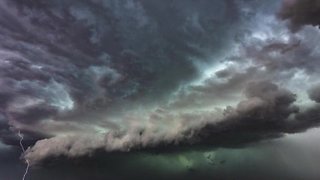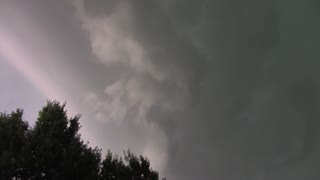Intense Hail Storm Hammers House
Hail is one of the biggest dangers with severe thunderstorms while it is usually small and relatively harmless. It may cause severe damage, injuries and in extreme cases even death. It forms as super cooled water droplets within a thunderstorm updraft begin freezing onto a condensation nucleus. The super cooled droplets are colder than 0 °C, but still in a liquid state. As they come into contact with the growing hailstone they freeze onto it, making it grow. The growing hailstone is kept in the air by the storm’s updraft until it grows too big and heavy for the upward wind to keep it aloft. The hailstone may make a single journey within the updraft, or it may make several journeys, each forming a new layer, producing a concentric onion-like structure.
Some hailstones form and grow by many smaller hailstones sticking and freezing together into a large hailstone – such form is called an agglomerate. The largest hailstones sometimes even form long icy horns or spines! The most severe hailstorms and largest hail are usually associated with super cell thunderstorms – it takes high to extreme instability, strong wind shear and dry mid-levels for very large hail to form. But just how big and heavy? Some weather effects are so unusual they catch the power of even the most silvery meteorologists.
This video is pretty insane and we have never seen anything like this! This took place near the window during a midnight storm. Crazy! Would you look at the size of the rocks, and that house. Wow, looking at this video we got pretty interested in hail storms. They are pretty extreme, and the man and women want to know more about it. How does hail storms form? It appears to be insane that softball-sized pieces of ice would rush through the sky on a midsummer's evening.
So what makes summer hail storms so extreme? What's more, what causes hail in any case? Hail structures when rainstorm updrafts are sufficiently able to convey water beads well over the solidifying level. This solidifying procedure frames a hailstone, which can develop as extra water solidifies onto it. In the long run, the hailstone turns out to be unreasonably overwhelming for the updrafts to help it and it tumbles to the ground. Hail, to put it plainly, is fundamentally a round of back-and-forth between rising breezes and gravity. Warm, dampness rich air is the essential fuel hot spot for rainstorms. The warm air gets consumed into a storm through the quickly developing breeze, known as an updraft, which powers the entire framework. Well, we have seen a lot of videos like that these days. To us, they are fascinating and scary at the same time. Dramatic footage shows how powerful hail storms caused flooding in a mountain house. The nonseasonal thunderstorms and torrential downpour lashed the town.
-
 1:58
1:58
ViralHog
5 years ago $1.79 earnedAftermath of Intense Australian Storm
5.56K -
 0:11
0:11
ViralHog
4 years ago $0.11 earnedTorrential Hail Storm
1K1 -
 0:40
0:40
shellectra
5 years ago $0.02 earnedIntense flash storm pounds home in Australia
1.06K -
 1:21
1:21
cdngreenwaterdiver
5 years ago $12.34 earnedFreak summer storm hammers Melbourne, Australia
3.04K -
 1:33
1:33
ViralHog
5 years ago $0.25 earnedIntense Storm Clouds in Kansas
963 -
 2:18
2:18
ViralHog
5 years ago $0.27 earnedHail Storm Batters Backyard Pool
962 -
 0:08
0:08
rumblestaff
4 years agoTerrifying Hail Storm Caught On Camera
4.11K1 -
 0:17
0:17
ViralHog
5 years ago $0.07 earnedHail Storm Beats and Batters a Car
508 -
 0:29
0:29
The_village_of_husky
4 years ago $9.63 earnedMind-blowing hail storm causes massive damage in Russian town
7.93K1 -
 2:04
2:04
ViralHog
5 years ago $0.02 earnedPing Pong Hail Storm in Texas
3301